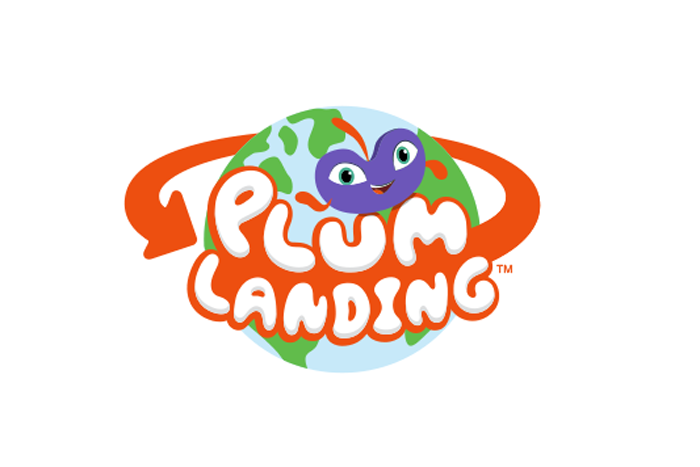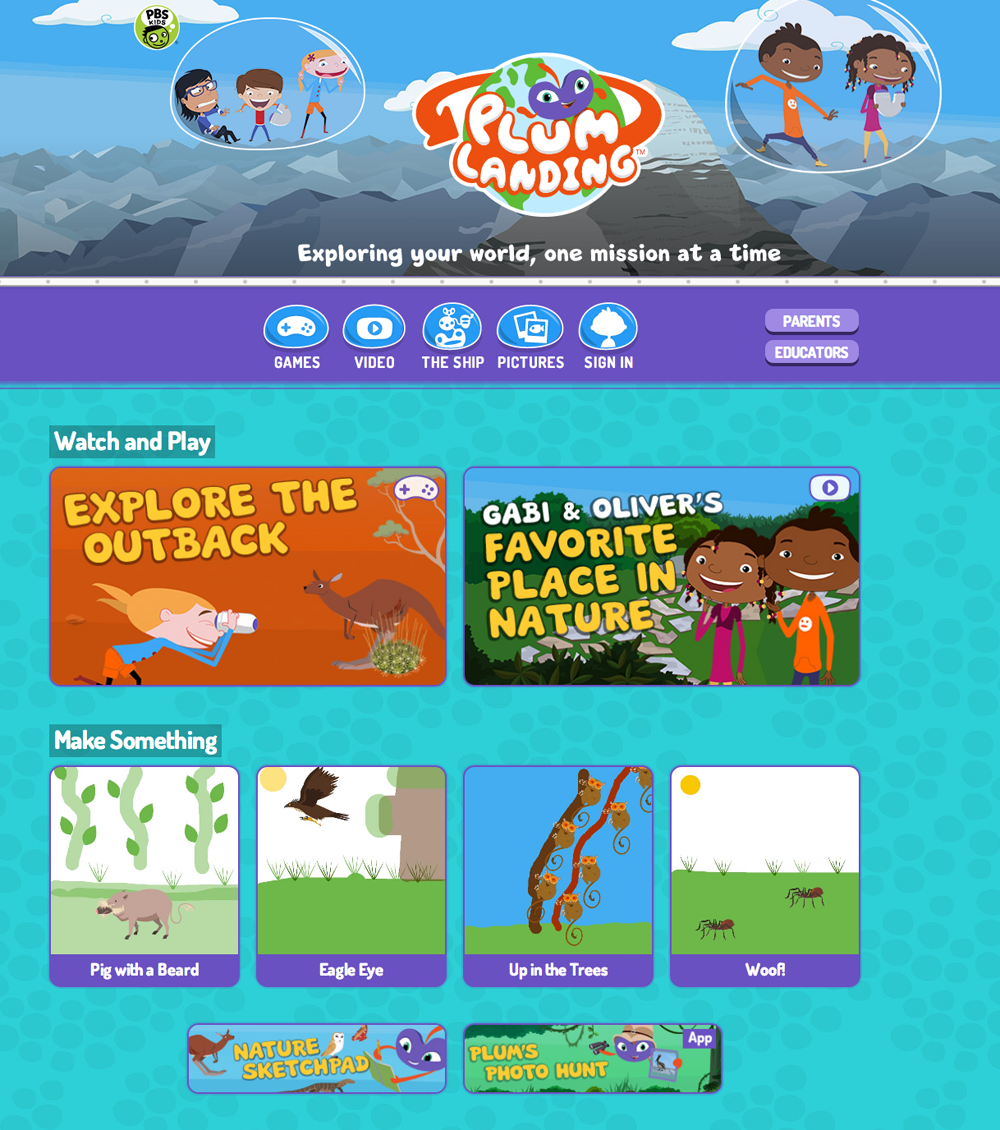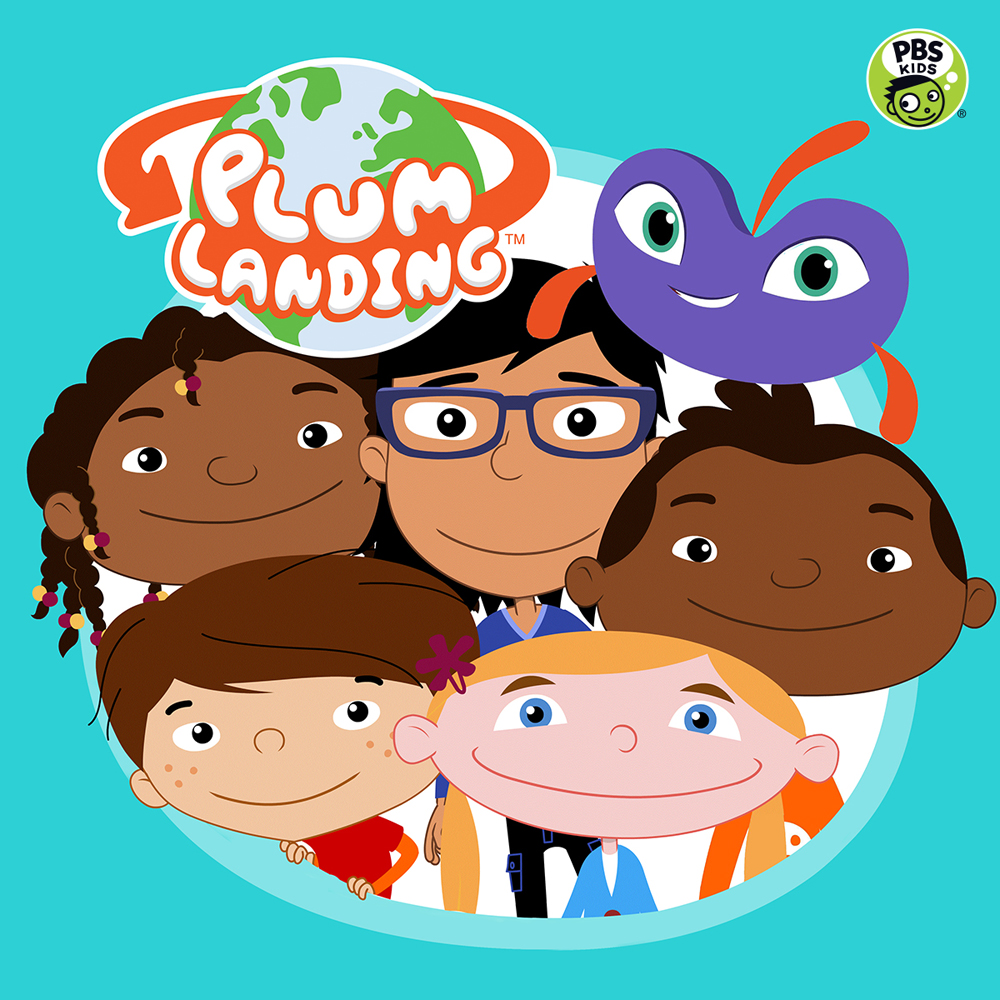Innovative Entertainment Model Designed to Get Kids Outside

This Behind the Scenes article was provided to Live Science in partnership with the National Science Foundation.
A second grader is about to start learning environmental science, along with a cute purple alien named Plum, and Plum’s friends. He goes online to a site where he can easily find these animated characters in “webisodes” and games. Within a few minutes, instead of being in front of the computer, he’s out in his yard — phone in hand — looking for signs of the change of seasons. This isn’t a child introduced to science through rote facts; it’s a child who is learning via a new multimedia project from PBS KIDS.
“Plum Landing,” an all-digital production created by WGBH in Boston, uses animated webisodes, online games, a mobile app, live-action videos and hands-on activities to increase children’s understanding of the science and systems of the natural world. As the program, which is designed for children ages six to nine, introduces core science concepts — particularly related to ecosystems — it models key habits of mind scientists and naturalists use when exploring the natural world. “Our goal was to give kids an understanding of the science underlying healthy ecosystems and sustainability, which we hope will lay the foundation needed for them to become caretakers of our planet later in life,” said executive producer Marisa Wolsky. [Kids and Science Good for More than Just a Grade ]

According to the narrative, Plum is a video game designer on the desolate Planet Blorb. She has landed on Earth to create games about nature for her fellow Blorbians. Many aspects of Earth, including plants, animals and clouds, fascinate Blorbians; they, including Plum, have been longing to experience nature on Earth.
So, Plum commandeers a space ship and flies to Earth, where she meets and befriends Clem, Oliver, Gabi, Brad and Cooper. Soon she’s sending them on missions to four different ecosystems — the Australian desert, the Canadian Rockies, the Belizean mangrove swamp and the Bornean jungle. Over time, Plum and her friends experience many mesmerizing and insightful discoveries about the planet.
Getting Kids Outside
On the website, children can click around and learn about the biodiversity of the ecosystems the animated characters are discovering. Children also are encouraged to investigate their real-world surroundings and document their progress using the web game Nature Sketchpad or the mobile app Plum’s Photo Hunt (iPhone, iPod Touch, iPad), allowing children to draw scenes or take photographs, explain their findings and submit them to the website.
Sign up for the Live Science daily newsletter now
Get the world’s most fascinating discoveries delivered straight to your inbox.

“Plum Landing” also provides parents and educators environmental science activities and curricula. A flexible digital curriculum offers informal educators (those at after school programs, clubs and camps) hands-on activities and media resources (live-action videos, webisodes, games, the app and sketchpad) organized by theme and supplemented with background information, discussion questions and ideas for further exploration. In one activity and video, for example, children learn about evaporation and the water cycle by painting with water on outdoor surfaces. They are meant to discover there is faster evaporation painting water on hot metal versus, say, concrete, which has a lower temperature. Through time-lapse photography, viewers also can see evaporation happen at different rates in the shade and sun.
Since its debut last April, the website has garnered more than 8 million page views via 1.5 million separate website visits. Children are not only watching the webisodes and playing the games online, but also exploring different aspects of their own environments — to date, they’ve submitted about 70,000 photos and drawings.

In collecting these photograph and drawings, WGBH says, it strictly follows the Federal Trade Commission’s updated regulations on the Children’s Online Privacy Protection Act (COPPA), designed to safeguard children under the age of 13 who are online. WGBH approves children’s submissions before they are posted on the website and prevents personal information, including photographs of children, from being shared on the site. Additionally, the website does not collect trace data or any information identifying the child. The PBS login system also has no identifying information when a child logs into the site.
“The drawing submissions from the online Nature Sketchpad and the photographic submissions from Plum’s Photo Hunt app feed in an orderly way into a Django database for which we have a user-friendly, Cloud-based administration for review, editing and posting,” Wolsky said. “In other words, we can review all submissions easily on a web page and mark them for publication. The images generated by kids, drawing or photos, are automatically formatted to be at the correct size for display in whichever of the 96 galleries we feed them to, so no additional design or production work is needed to prepare them for display.”
Not on TV
Back in 2006, when WGBH first decided to create this multi-platform project, it envisioned a televised and digital production. The idea was to create a half-hour television series comprised of two shorter segments, 11 minutes each, accompanied by a robust website. However, WGBH decided that it wanted to break new ground by going all-digital. According to Senior Executive Producer Kate Taylor, the National Science Foundation, which supported this project through planning grants and a full-scale development award, and the Corporation for Public Broadcasting, another funder, were both interested in an innovative way to model and teach science concepts.
“We knew that the media habits of kids were changing and that short videos were an excellent tool for building awareness and reaching kids who are increasingly spending more of their time watching video online,” said Taylor. “So, it became very exciting for us to do a one of a kind, cutting edge foray into an all-digital series.”

Up Ahead
WGBH is now working on a family engagement campaign for the fall, a national initiative designed to appeal directly to families to get outside, connect with nature and explore their surroundings. In July, an outside evaluator, the Concord Evaluation Group (CEG), will conduct an evaluation to measure the impact of “Plum Landing” resources on kids and their families.
“Parents want to investigate the outdoors with their children, but finding the time and giving them the guidance that they need is a challenge,” said Wolsky. “We are just starting to tackle that challenge, and I think we are going to learn a lot in the next few months.”
Evaluating the curriculum for informal educators is another step that WGBH plans to take. The CEG will be conducting another study with after-school programs in the fall.
“At WGBH, we want to make sure that, when we produce media resources, we give educators the tools they need to enhance the impact they have on their students’ learning,” said Wolsky. “This includes not only aligning the resources to the standards, but also providing discussion questions, hands-on activities, ideas for further exploration of the science topics, and ways that educators can make connections between what they see in the media and things they are doing in their own world.”
WGBH is still looking to see what the future holds for the project. Plum may soon play a role in the museum setting. In fact, the Ecotarium Museum in Worcester, Mass., recently celebrated Earth Day with a “Plum Landing” screening, hands-on activities and giveaways. This fall, “Plum Landing” also plans to offer more games, a new app and additional resources that encourage indoor-outdoor science exploration.
“Many of us in public media are now creating projects that are much more focused on reaching increasingly mobile audiences. During this time, we have also seen an expansion of interest in projects that have environmental science curricula. There’s an urgent need here: Very few informal education projects are successfully teaching America’s children the science concepts underlying sustainability.” said Wolsky. “’Plum Landing’ promises to do that by creating an educational science experience for elementary-aged children that will enable them to think about the world in a new way.”
Editor's Note: The researchers depicted in Behind the Scenes articles have been supported by the National Science Foundation, the federal agency charged with funding basic research and education across all fields of science and engineering. Any opinions, findings, and conclusions or recommendations expressed in this material are those of the author and do not necessarily reflect the views of the National Science Foundation. See the Behind the Scenes Archive.
'A relationship that could horrify Darwin': Mindy Weisberger on the skin-crawling reality of insect zombification
'Dispiriting and exasperating': The world's super rich are buying up T. rex fossils and it's hampering research
Trove of dinosaur footprints reveal Jurassic secrets on Isle of Skye where would-be Scottish king Bonnie Prince Charlie escaped











